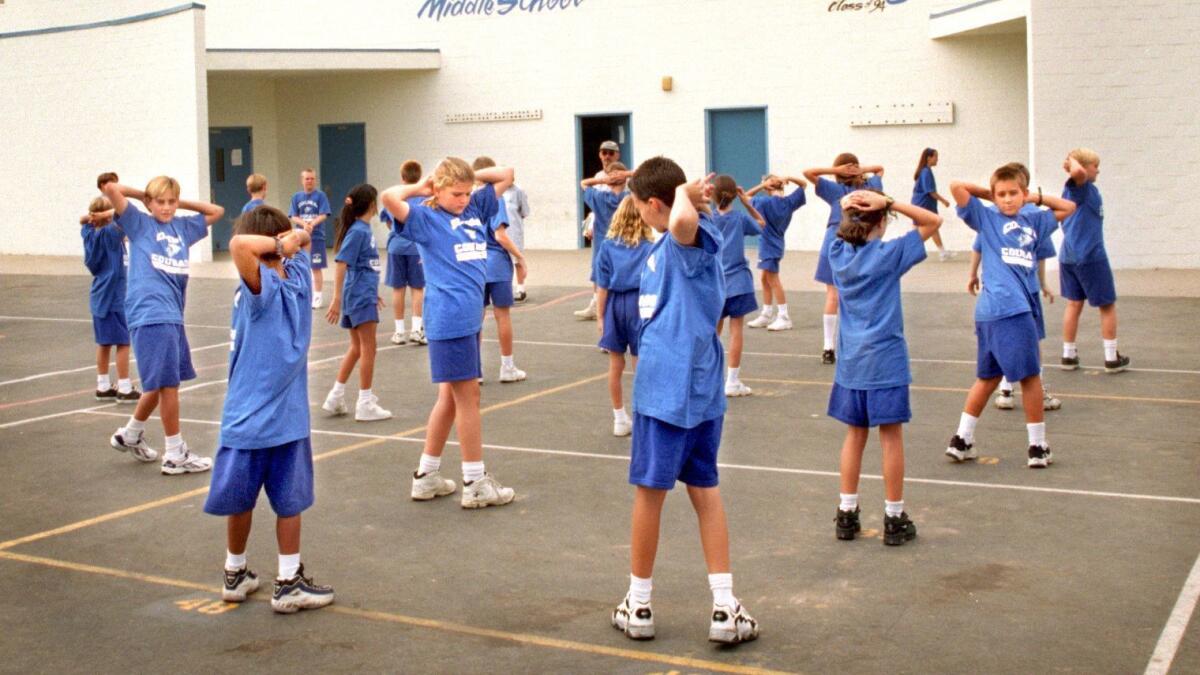Column: Newport-Mesa bucks the national trend to make P.E. more relevant and inclusive

- Share via
I try not to think about the indignities I endured long ago in middle-school gym class, but when I read a recent article in The Atlantic it all came rushing back:
The exasperated P.E. teachers with their impressive calf muscles and overused whistles. My embarrassing lack of natural athletic ability. Self-conscious shuffling and eyes-cast-downward mortification in the locker room. Choking clouds of body spray melded with the musky scent of humiliation. The torment of communal showers.
So many other not-fond memories come back to me — like the time I ran head-first into a pole on a baseball backstop, knocked myself silly and split my eyebrow open. My perpetually bloody and scabbed knees and elbows. Getting bonked on the head by a volleyball so many times the gym teacher sarcastically suggested that I should get my eyes checked (turns out I did need glasses).
So when I read the headline “Gym Class Is So Bad, Kids Are Skipping School to Avoid It,” my first thought was, “So what’s new?”
But my second thought was to question why, many decades after my uncomfortable memories were formed, we still haven’t summoned the will to make physical education smarter, more effective and engaging for all students.
To be sure, the goals of physical education and the benefits of a well-designed program are undeniably positive, and given that childhood obesity has been identified as a national crisis, we shouldn’t dismiss its importance.
In theory, P.E. should improve both students’ physical fitness and their academic achievement, and encourage healthier lifestyle choices going forward.
Unfortunately, according to the sources cited in The Atlantic article, P.E. class has too often become a prime example of when the best of intentions go awry.
In many cases, researchers have found, P.E. does little to nothing to improve physical fitness and long-term health outcomes, and is often linked to truancy and other disciplinary problems.
For example, a years-long program in Texas that was specifically designed to improve middle-schoolers’ fitness levels failed to achieve its health and educational goals, a study found. Worse still, a troubling correlation was found to exist between the program and increasing discipline and absence rates.
A robust P.E. program is known to have critical links to academic success, but the opposite is also true. In one recent finding, for example, a study out of Chicago concluded that failing P.E. in ninth grade — an occurrence more common than might be assumed — was just as damaging to graduation prospects as failing key academic classes such as English, math or science.
One reason that some students find it difficult to connect with structured physical education programs, researchers believe, is the prevalence of bullying.
Gym classes are prime breeding grounds for abusive behavior. Kids get picked on for lacking athletic talent, and they get body shamed and pushed around in minimally supervised locker rooms.
There’s another problem worth noting. I really hate to keep piling so much blame onto No Child Left Behind — there are already so many reasons to criticize it — but in the decades since NCLB became federal law, the drill-and-test culture it fostered led to widespread cutbacks in P.E. classes and in recess and other break time that previously allowed students to get up and move around during the school day.
Experts say the most effective P.E. programs don’t necessarily require more money for fancy equipment, and they shouldn’t be strictly geared around skill tests and structured activities with singular goals — like timed runs around a track. Instead, they should be more holistic in nature.
In other words, physical education should build in a variety of components, including free, unstructured play time, with adjustments made for varying skill levels and an emphasis on healthy living and nutrition.
Such thinking appears to have influenced the direction of physical education at Newport-Mesa Unified School District.
P.E. in the district does still involve fitness testing, as required by state standards, on such basic activities as running, pushups and pull-ups. But it also incorporates a healthy lifestyles curriculum, a diverse range of offerings — including weight training, dance and yoga — and the recent introduction of more nontraditional types of activities such as pickle ball and Frisbee.
“Physical education is more than just rolling the balls out and letting them play,” said Kirk Bauermeister, Newport-Mesa’s executive director of secondary education. “We hope that our students walk away with an understanding of healthy living and eating, as well as how important staying active is for overall health.”
It’s good to know that efforts are being made at Newport-Mesa to make P.E. more relevant and inclusive. But the evidence suggests that the broader education system still has a way to go.
It was only after my school days were long behind me that I learned to embrace physical fitness. I now play tennis regularly, work out religiously and deeply appreciate the benefits of a healthy, active lifestyle.
If there’s hope for a near-sighted, two-left-feet klutz like me, then there’s certainly reason to hope that we can get P.E. right.
Patrice Apodaca is a former Los Angeles Times staff writer, and is the coauthor of “A Boy Named Courage: A Surgeon’s Memoir of Apartheid.” She lives in Newport Beach.
All the latest on Orange County from Orange County.
Get our free TimesOC newsletter.
You may occasionally receive promotional content from the Daily Pilot.




